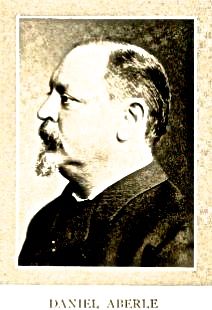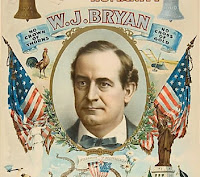
Daniel Aberle was born in 1848 in Baden, Germany, the son of Lazarus and Karoline Mayer Aberle. Educated in the good German schools, at the age of 22 he decided to seek his fortune in the United States, boarding a ship that took him to New York City. He must have seen what he liked in the Big Apple because he stayed for the next seven years. Aberle’s employment during that period has not come to light but my surmise is that for at least some of the period he was working in the liquor trade.
In New York he met Amelia Stern, born in New York,. The 1870 census records her as a girl of sixteen working as a clerk, almost certainly in the “fancy goods” store run by her 46-year old mother, Barbara, a German immigrant. Although no man was recorded as present in the Stern household, Barbara is listed by the census having six children, ranging in age from eighteen to one year. A puzzle.
Daniel and Amelia were married in Manhattan in 1878. Almost immediately after, apparently being aware of an opportunity, the newlyweds left New York City and headed 1,200 miles west to St. Joseph, Missouri. "St. Joe", as it was commonly called, was a jumping-off point for migrants headed to West. Pioneers would stay and purchase supplies before they heading out in wagon trains across the Great Plains. Although this traffic had slowed after the Civil War, the city had continued to grow steadily.
Aberle is reported to have opened a wholesale liquor store in St. Joseph in 1878 and pursued the business for about next six years. The couple’s first two children would be born there, David W. in 1879 and Edward M. in 1881. The 1880 census found the family in St. Joseph, along with Amelia’s younger sister, Emma, and three of Daniel’s adult cousins, Morrris, Sidney and Iela Flarsheim, The Flarsheim men apparently were working as salesmen for Aberle. The busy household was completed by a live-in maid.
Business in St. Joseph apparently was not up to Abele’s expectations. In April 1882, Aberle moved his family and liquor house 425 miles almost directly north to St. Paul, Minnesota. It would be his last move. The 1883 St. Paul city directory records D. Aberle & Company “Wholesale Wines and Liquors” at 409-411 Sibley Street. Morris Flarsheim now was in management. By 1886, an apparent need for more space prompted a move to 236 East Seventh Avenue. A postcard view of that block reveals an Aberle sign at the far left of the image.



Parks and politics apparently never distracted Aberle from his main concern — selling liquor. By 1901, the year of his parks appointment, he had taken on a partner named Westheimer. His eldest son, David, was now the secretary of the liquor house. By 1905 Westheimer had departed and Aberle’s second son, Edward, joined the firm. David became vice president; Edward, secretary and treasurer. Incorporated and moved to 138 Third Street, the company name was changed to Daniel Aberle & Sons.
These changes were reflected in a tray-shaped saloon sign, featuring a woman dressed in a fancy gown and well-quaffed hair preparing to drink a shot glass full of whiskey while a bottle of “Golden Link” sits nearby on a dresser. The motto is “Worth Asking For.” My educated guess is that it refers to the liquor rather than the lady. The brand also was advertised in a back-of-the-bar bottle. Another Aberle label was "Governors Special Bourbon."
Aberle continued to manage the wholesale liquor business until his health failed. He died in 1916 and was buried in Mount Zion Temple Cemetery in St. Paul. A large monument denotes the spot. Eight years later Amelia would join him there. The Aberle sons continued to manage the liquor house until shut down by National Prohibition in 1919. Subsequently, David became president of a wholesale confectionary company and Edward maintained an office in St. Paul’s Pioneer Building.
The story of Daniel Aberle’s rise from penurious German immigrant to wealthy and influential American citizen was captured in two 1907 publications. In one Aberle was counted among the “leading men of Minnesota.” In the other, he was featured as one of “the big folks in Minnesota.” In short, he had come a long way from Baden.
Note: The two books alluded to above are “The Book of Minnesotans: A Biographical Dictionary of Leading Men of the State of Minnesota” by Albert Nelson Marquis, and “Sketches of Big Folks in Minnesota,” transcribed by Marilyn Clore. Both 1907 documents provide details of Aberle’s life.










I can fill you in on some of the details of Daniel's wife Amelia, and her family's other connections to the whisky business. Amelia is my 1st cousin 3 times removed. Her father's name was Jacob Stern (or Sterne), but I know nothing else about him. I imagine that Barbara Stern was a widow by 1879. Barbara's parents were Meyer and Ella Flarsheim who immigrated to NYC in 1848 with their seven children, 2 boys and five girls. Barbara was the oldest and already married to Jacob Stern, so he likely came with the family group. Meyer Flarsheim died shortly after the move to New York, and several member of the family, including the matriarch Ella moved to St. Joseph, MO. I'm sure that is part of why Daniel and Amelia decided to move there. The youngest of Barbara's sisters, Sarah Flarsheim had made the move to St. Joe. It was there that she met and married Ferdinand Westheimer, maker of Red Top Rye, who has already profiled on this blog.
ReplyDeleteI don't know why Danielle and Amelia decided to leave St. Joe, but her uncle, Henry Flarsheim may have already lived there. His two sons, Morris Flarsheim (a different cousin from the Morris Flarsheim that lived in St. Joe) and Alfred Flarsheim (aka A.B.) both spent time in St. Paul. In the 1890's, both Morris and A.B. went to work for Bernheim Brothers (I.W. Berheim, president), and relocated to Louisville. Both became officers and partners in the Bernheim Brothers whisky business.
Bill: Thanks for providing the details on some of the great distilling figures of pre-Prohibition America.
ReplyDelete